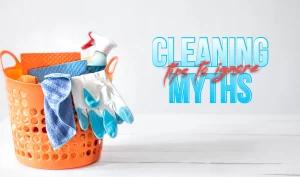
Many old-school cleaning methods are great, but keep in mind that not all of them are to be trusted nowadays. In this article, we will share some common cleaning myths that you should simply stop falling for. They are often not the best approach and may even damage your home.
Most of these tips may have been great for their time. However, everything has changed and so have products and materials. What worked back in the old days, may not work in modern times. If you ever use some old-fashioned cleaning tricks, make sure they will not damage your belongings.
Here are some old-school cleaning tips you should avoid
Myth: Always polish your furniture
In the 1920’s commer commercial furniture polish contained wax, soap, and water. It polished your pieces but also cleaned them. Nowadays polishes do not do much when it comes to cleaning. If you keep polishing your furniture without cleaning it first, you will trap dirt, oil, and humidity. Over time, you will end up with sticky furniture that looks dull.
Truth: Using a damp cloth for dusting, works great on most furniture. Add a little vinegar to the water if you are dealing with heavy grime. When you want to polish – wipe your furniture well and use a homemade polish that will moisturize your wood but not create buildup.
Myth: Newspapers are best for glass
Newspaper and vinegar used to be the best way to clean windows back in the day. You could scrub the glass with one side, flip it and buff it to a shine. This was possible because newspapers used to be thicker and sturdier. Nowadays, papers are printed with thin paper that falls apart when wet. If you use it, you will end up leaving bits of paper and wood fiber on your windows.
Truth: A damp microfiber cloth will work great for most windows. You can also use a homemade window cleaning solution and a squeegee if you have to deal with extra dirty glass.
Myth: Too much vacuuming will damage your carpets
Old-school vacuum cleaners were rather powerful and ended up lifting the carpet from the pads. This would be harmful to their surface.
Truth: Vacuum cleaners nowadays use roller brushes that are not as harsh on carpets. Also, most carpets are synthetic so you should make sure to vacuum them at least once a week to prevent dirt from chemically bonding with their fibers.
Myth: Dust after vacuuming
If back in the day vacuuming your carpets raised a lot of dust, today that is not the case.
Truth: You should always dust everything, wait a few minutes for everything to settle on the floor, then vacuum. Always move top to bottom when cleaning a room.
Myth: Whatever is clean, is also safe
Back in grandma’s day houses were cleaned with chlorine bleach and lye-soap. Even though both things are powerful cleaners, they are far from safe. They create serious health and environmental hazards. This is why they are no longer used or recommended.
Truth: Disinfectants will not properly clean the surface you are treating. Nowadays it is best to use soap and water to clean the area first, then use a disinfectant to kill the rest.
Myth: Big messes require more product
Old-fashioned soaps may have worked like that. Most of them used to be fat-based and produced a lot of suds which created the impression that more lather had more cleaning power. Modern cleaning products mainly rely on synthetic ingredients and enzymes that dissolve dirt and stains. They rarely produce much lather and people, in fact, prefer foam.
Truth: Using too much product leaves behind residue. Whether it is laundry, your carpet or your bathroom, the residue builds up and makes things look dull and attract even more dirt. The same goes for homemade cleaning products. According to cleaning professionals too much vinegar, for example, will corrode metals, as well as reduce the cleaning power.
However, there are some vintage cleaning tips that are still brilliant today.
- Air drying your clothes – Fresh air and sun are natural disinfectants and will safely dry and refresh bedding, clothes and even shoes. If you have some damp clothes, protect them from mould and mildew and hang them outside.
- Soda for pans – When you have some tough pots or pans that you struggle to clean, make a baking soda and water mixture and rub it on the inside. Scrub with a coarse sponge and rinse with warm water.
- Lemons for a fresh kitchen sink – If your kitchen sink is starting to smell, rub it with some lemon, rinse it, then leave a lemon wedge or peel at the bottom of it. When washing dishes, it will automatically refresh everything. You can use this trick for your smelly garbage bin. Just place half a lemon at the bottom of it.
